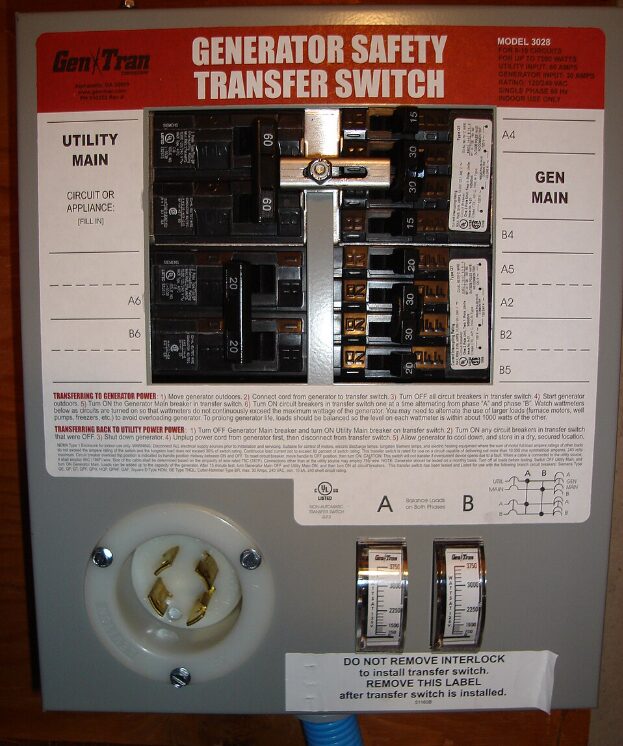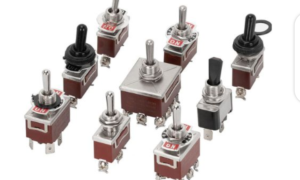Power outages are becoming more frequent in the US and last longer due to factors like extreme weather, an aging grid, and increasing demand. This has made backup systems necessary to keep people and critical facilities powered and online 24/7. Solar and their associated battery backup systems have been widely adopted, especially in the sunny states, but large installations usually use generators to provide backup power. Either way, these backup systems need changeover or transfer switches, which allow you to switch from the mains AC power supply to the power backup system and back manually or automatically. Here are the steps to follow when wiring this component.
A manual electrical transfer switch
How To Wire a Single-Phase Manual Changeover Switch
This changeover switch has 6 pins.
- Mains AC live
- Mains AC neutral
- Backup AC live
- Backup AC neutral
- Load AC live
- Load AC neutral
On the utility AC side, there should be the meter and main switch before the transfer switch. Connect the live wire from the main switch to the mains AC live pin by loosening the screw, inserting the stripped wire, and tightening the screw to secure it. If you’re in the US, this live wire in a single-phase connection should be black. But in the UK, it will be brown. Ensure you follow the wire color codes in your country.
Next, hook up the neutral line from the circuit breaker to the switch, which can be white, gray, or blue, depending on the country.
On the backup side, repeat these steps using wires from the backup circuit breaker, which can be supplied by an inverter (battery power) or generator.
The last part is to tie the load wires in the changeover switch, which go to the house’s main circuit breaker in the electrical panel. This component then connects to the MCBs for the different circuits in the home and the earth/ground busbar provides the earth connection afterward.
How To Wire a Single Phase Automatic Changeover Switch
This changeover switch is similar to the manual type, except that it detects when the utility power goes off and switches automatically to backup power. When utility AC is restored, this transfer switch switches back to it. So its internal operating mechanism is more advanced but the terminals are the same, save for one small difference. This one has 8, which are:
- Mains AC live
- Mains AC neutral
- Backup AC live
- Backup AC neutral
- Utility Load AC live
- Utility Load AC neutral
- Backup Load AC live
- Backup Load AC neutral
In the wiring, the utility and backup AC live load terminals should be connected to supply power to the house’s main circuit breaker. Same case applies to the utility and backup neutral terminals. The logic here is that when the switch is on the utility side, there will be no contact with the backup side, so there won’t be any safety risk.
How To Wire a Three-Phase Manual Changeover Switch
In three phase power, there are three live wires, so this changeover switch has more terminals than the single-phase type. In total, there are 12.
- Utility L1
- Utility L2
- Utility L3
- Utility N
- Backup L1
- Backup L2
- Backup L3
- Backup N
- Load L1
- Load L2
- Load L3
- Load N
The utility terminals are usually on the upper side of the switch, and they connect to the mains AC power supply using color coded wires (black, red, and blue) or (brown, orange, and yellow). Backup and load terminals are usually on the lower side. Each power supply system has one neutral wire for the three-phase wires, which is switched to connect utility or backup AC to the load.
How To Wire a Three-Phase Automatic Changeover Switch
This automatic changeover switch is similar to the manual type in terms of the electrical connections, but it can have four additional terminals to provide a full set of load pins for both the backup and load connections. The utility load L1 and backup load L1 can be connected, same with the L2s, L3s, and neutral terminals to send power to the main circuit breaker.
General Precautions Before Wiring
Always disconnect the main power source by turning off the main switch before doing this wiring. Also, you must have the correct personal protective equipment and tools before doing this installation. Some of the technical details to check before buying the changeover switch are its voltage and ampere ratings, as well as the wire harness size (gauge), which should match the load current and voltage.
In some areas, it is illegal to do this wiring as a DIY project, so you might have to hire a licensed electrician.
Wrapping Up
Wiring changeover switches is relatively easy but you have to be careful with the device and wire ratings to ensure they don’t burn out. In most cases, you’ll need high-voltage wire harnesses for these connections. If installing the battery backup system from scratch, you’ll also need battery cable assemblies. Generator installation is easier than dealing with batteries, but you’ll still need properly-sized cabling. To be on the safe side, I recommend consulting the experts on matters cabling, and Cloom Tech or Wiringo can help you out.



































